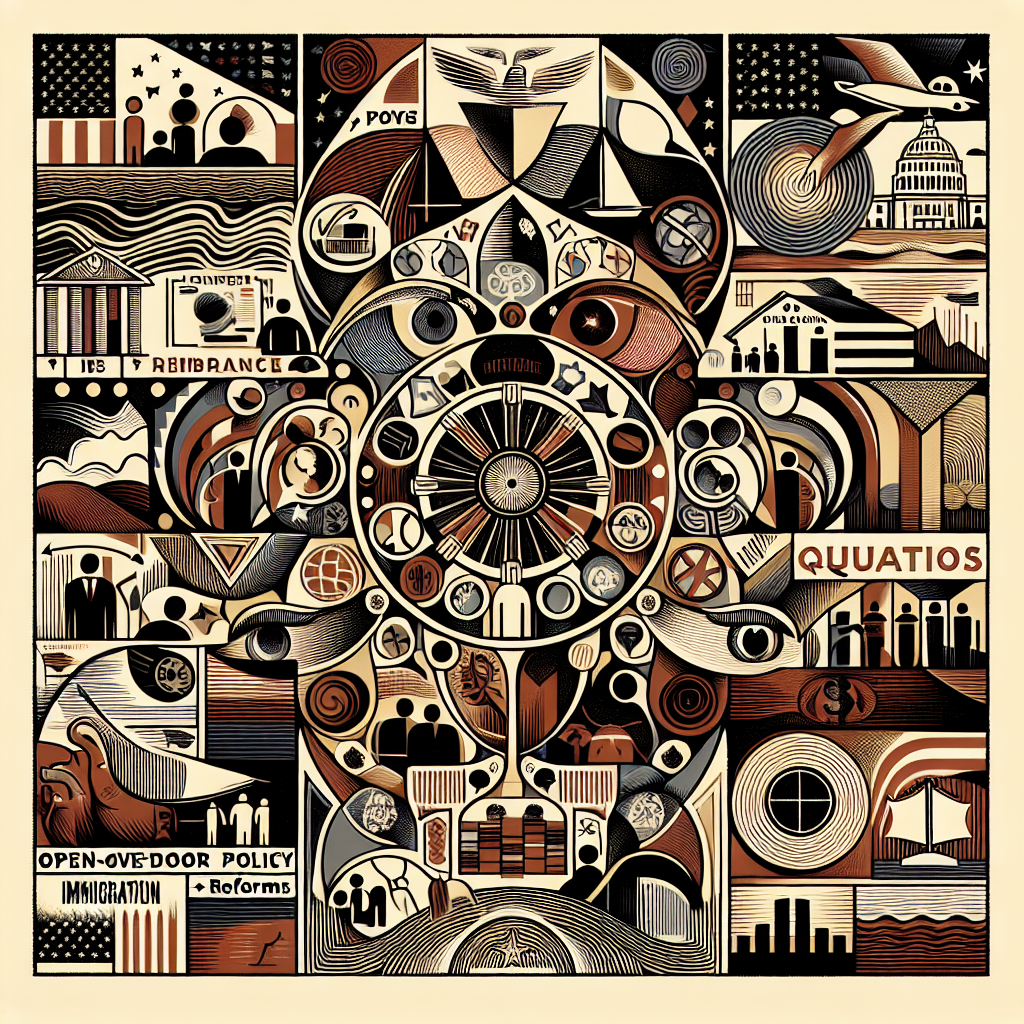The Evolution of American Immigration Policy

The Continuous Journey of Shaping American Immigration Policy
From its inception, America has been a beacon of hope and opportunity for people worldwide, inviting them to its shores in search of better prospects and a brighter future. This narrative is intrinsically linked to the evolution of American immigration policy, a dynamic, complex, and often contentious journey. Reflecting the nation's changing social, economic, and political landscapes, the immigration policy has continuously transformed and adapted to the times. This article explores this fascinating journey, delving into the intricacies and evolution of immigration policies that have contributed to shaping the diverse and multi-ethnic society that America is today.
🇺🇸 Immigration Snapshot (2025):
• 1 in 7 U.S. residents is foreign-born
• Over 1 million legal immigrants arrive annually
• Top countries of origin: Mexico, India, China
• DACA protects approx. 580,000 individuals
Introduction
A look at the history of U.S. immigration policies that led to today's complex system
🧠 U.S. Immigration Policy Mini Quiz
The evolution of American immigration policy is a complex and dynamic topic, reflecting the changing socio-economic and political fabric of the country. From the open-door policy of the early years to the more restrictive laws of the 20th century and the ongoing debates today, US immigration policy has continually evolved to address the country's needs and challenges.
The Early Years: An Open-Door Policy
During the 18th and 19th centuries, the US had an open-door policy. The country was expanding, and there was a need for labor to work on the farms, factories, and burgeoning industries. There were no federal laws regarding immigration, and anyone who could make the journey could settle in the US. For instance, during the Irish Potato Famine in the 1840s and 1850s, over a million Irish immigrants were able to settle in the US.
The Late 19th Century: The Advent of Restrictions
By the late 19th century, attitudes towards immigration began to change due to economic downturns and growing nativism. The Chinese Exclusion Act of 1882, which barred Chinese laborers from entering the US, marked the country's first restrictive immigration law. This Act emerged from fears that Chinese immigrants were taking jobs from American workers and was a clear departure from the prior open-door policy.
The Early 20th Century: Quotas and More Restrictions
In the early 20th century, the US government introduced the National Origins Act of 1924, which further restricted immigration by establishing quotas based on national origin. This policy was designed to preserve the demographic makeup of the US, favoring immigrants from Western Europe and restricting those from Eastern Europe and Asia.
Post-World War II: Shift Towards Family Reunification and Skills
After World War II, American immigration policy evolved to focus more on family reunification and attracting skilled workers. The Immigration and Nationality Act of 1965 abolished the national-origins quotas, prioritizing family reunification and attracting skilled labor. For instance, this Act allowed tech professionals from countries like India and China to immigrate to the US, leading to a significant shift in the demographic makeup of immigrants.
Contemporary Era: Ongoing Debates and Challenges
In the contemporary era, American immigration policy continues to be a contentious issue. Debates revolve around border security, the treatment of undocumented immigrants, and the economic impact of immigration. Recent policies like the Deferred Action for Childhood Arrivals (DACA) program, which provided temporary protection to undocumented immigrants brought to the US as children, reflect the ongoing evolution of American immigration policy.
— Madeleine Albright, former U.S. Secretary of State
📅 Key Milestones in U.S. Immigration Policy
- 1790: Naturalization Act limits citizenship to “free white persons.”
- 1882: Chinese Exclusion Act enacted.
- 1924: National Origins Act introduces immigration quotas.
- 1965: Immigration and Nationality Act ends national-origin quotas.
- 2012: DACA implemented for undocumented youth.
Conclusion
The evolution of American immigration policy reflects the country's changing needs, challenges, and attitudes towards immigrants. As America continues to grapple with these issues, its immigration policy will undoubtedly continue to evolve. Understanding this history is critical to informing current debates and shaping future policies.
Use Case 1: Academic Research on Immigration Policy
A scholar engaged in research on the dynamics of American immigration policy can leverage a comprehensive article on 'The Evolution of American Immigration Policy' to trace the historical changes and transformations. This content can provide a chronological overview of policy changes, starting from the colonial era to the present day, shedding light on the various laws, acts, and reforms that have shaped American immigration. The scholar can use this information to understand the sociopolitical implications of these policies and how they have influenced the immigration patterns and demographic changes in the United States. Additionally, the content might provide insights into how immigration policy has shaped, and been shaped by, public sentiment and political discourse over the centuries.
Use Case 2: Policy Advocacy and Activism
Non-profit organizations and advocacy groups working on immigration issues can utilize an in-depth article on 'The Evolution of American Immigration Policy' to inform their advocacy strategies and campaigns. This content can provide a historical context to current policies, thereby enabling these groups to build more persuasive arguments and narratives around immigration reform. For instance, if the content discusses how past policies have contributed to the marginalization of certain immigrant groups, these insights can be used to advocate for more inclusive and equitable policies. The content can also be used for public education campaigns aimed at fostering a better understanding of immigration issues among the general public.
Use Case 3: Policy Formulation and Decision-Making
Policy makers and government officials can benefit from an article on 'The Evolution of American Immigration Policy' when formulating new immigration policies or reviewing existing ones. The content can provide valuable lessons from history, highlighting the potential impacts and unintended consequences of certain policy decisions. For example, if the content discusses how restrictive immigration policies in the past have led to labor shortages or economic stagnation, policy makers can take these factors into consideration when crafting new legislation. The content can also help policy makers to anticipate potential political and public reactions to new policies, based on historical precedents. Title: The Evolution of American Immigration Policy Introduction The evolution of American immigration policy is a compelling history that reflects the changing political, economic, and social climate of the country. Since its establishment, America has grappled with the challenge of creating a balanced immigration policy that ensures national security while promoting economic growth and upholding the nation's foundational principles of diversity and inclusion. Early Policies and Open Immigration In the early days of American history, the U.S. had virtually open borders. Immigration policy was hardly existent, and the country welcomed immigrants to settle the vast and undeveloped lands. The Naturalization Act of 1790 laid the groundwork for American immigration policy, granting citizenship only to "free white persons" of "good character," thus revealing the racial bias inherent in early immigration laws. The Rise of Restrictive Policies In the late 19th and early 20th centuries, the U.S. began to implement restrictive immigration policies. The Chinese Exclusion Act of 1882, for example, was the first significant law restricting immigration into the U.S., prohibiting all immigration of Chinese laborers. The Immigration Act of 1924, also known as the National Origins Act, established quotas that severely limited immigration from Eastern and Southern Europe. Shift Towards Family Reunification and Skills-Based Immigration The Immigration and Nationality Act of 1965 transformed American immigration policy by replacing the national origins quota system with a preference for family reunification and skilled immigrants. This shift reflected an evolving consensus that America's strength derived from its diversity and the talents of its immigrant population. Recent Developments and Debates In recent years, immigration policy has become a hotly debated topic, with discussions centered on border security, the status of undocumented immigrants, and the balance between family-based and skills-based immigration. The Deferred Action for Childhood Arrivals (DACA) program, enacted in 2012, has been a significant policy in this debate, providing temporary relief from deportation for undocumented immigrants who came to the U.S. as children. Conclusion The evolution of American immigration policy showcases a dynamic process shaped by various factors, including economic needs, national security considerations, and societal attitudes towards immigrants. As the country moves forward, it is crucial to remember that the policy decisions made today will significantly impact America's demographic makeup, economic vitality, and social fabric in the future.
1. How has the American immigration policy evolved over time?
The American immigration policy has seen significant changes since its inception. In the 19th and early 20th centuries, the policy was largely unrestricted, welcoming immigrants from around the world. However, after the Immigration Act of 1924, the policy became more restrictive, imposing quotas based on national origin. The policy was liberalized again with the Immigration and Nationality Act of 1965, removing the quota system. Today, the policy is a mix of family reunification, employment-based immigration, and humanitarian relief.
2. What was the Immigration Act of 1924?
The Immigration Act of 1924, also known as the Johnson-Reed Act, established a quota system based on national origin. It significantly limited immigration from certain countries, particularly those outside Western Europe, to preserve the ethnic and racial composition of the United States.
3. What changes were brought about by the Immigration and Nationality Act of 1965?
The Immigration and Nationality Act of 1965 removed the quota system based on national origin established by the Immigration Act of 1924. It prioritized family reunification and skilled labor, leading to a more diverse immigrant population in the U.S.
4. How has American immigration policy affected the country's demographics?
American immigration policy has played a significant role in shaping the country's demographics. The quota systems of the early 20th century resulted in predominantly European immigration. The liberalized policies post-1965 led to more diverse immigration, particularly from Latin America and Asia, contributing to the multicultural fabric of the U.S. today.
5. What are the current focuses of American immigration policy?
Today, American immigration policy focuses on three main categories: family reunification, employment-based immigration, and humanitarian relief. There is also an ongoing debate about how to address undocumented immigrants and border security.
6. How does American immigration policy compare to other countries?
Compared to other countries, the U.S. has one of the most comprehensive immigration policies, providing multiple pathways for entry. However, its policy is also among the most debated, with ongoing discussions about reform to address issues such as undocumented immigration and the economic impact of immigration. In conclusion, 'The Evolution of American Immigration Policy' is an essential narrative that holds relevance across various industries and time periods. For both historians and policy-makers, this evolution provides crucial insights into the country's shifting values and priorities. Business leaders can use this information to understand how labor markets have changed over time, and how future policy changes might impact their workforce. For educators, it serves as a rich resource that can help students understand the complexities of immigration policy and its profound impact on shaping the social, economic, and cultural landscape of America. Regardless of your industry or era, understanding the evolution of American immigration policy is crucial to comprehending the diverse and dynamic nature of the United States. It serves as a reminder that our present and future are closely tied to our past, providing lessons we can apply as we navigate the complexities of our increasingly globalized world.




